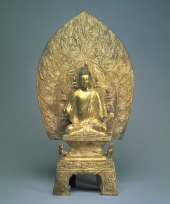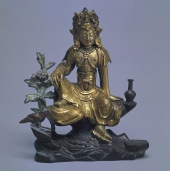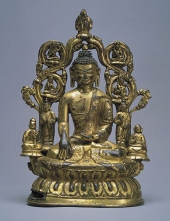|
Tags: art | Buddhism | sculpture
Buddhist sculptures arose out of the belief system that produced them. They are derived from the iconography in Buddhist sutras. Buttressed by the popular religious concepts of the time, they aptly convey the spiritual content in which the religion is rooted. Believers thought that the production of these sculptures would bring about good fortune; practitioners meditated with these images in order to bring about a deeper understanding and wisdom. Religious sermons made use of such profound sculptures to align and intensify the believers' conception of the Buddhist realm.
Among single Buddhist sculptures, one often finds sculptures of the Buddha, Buddhist monks, Bodhisattvas and guardian deities. The Buddha is at the core of the belief and represents the attainment of enlightenment. Disciples rendered in the form of monks transmitted his teachings after his death. Bodhisattvas were made in the image of a secular, royal prince—having reached Buddhahood, they chose to stay in this world in order to assist those who have not. Guardian deities look ferocious, but they avert physical enemies and internal demons. Then there are stupas, representing Nirvana. All these come together to compose the fundamental elements of Buddhist art.
Besides the religious content of Buddhist sculptures, these objects also possess their independent artistic merit. Northern Wei sculptures tend to be modest and simple. T'ang sculptures are often rotund and lively. Starting from the Sung era, sculptures became more closely associated with ordinary people. In addition to revealing the technical development of each period, they also reflect their makers' standards of beauty. Thus, appreciating religious sculpture not only imparts their ideological ideals, but also conveys universal concepts of beauty.
Buddhist Art of the Northern Dynasty

|
Gilt bronze Shakyamuni Buddha,
Mark of T'ai-ho reign 1st year, Northern Wei dynasty.
|
Emperors of the Northern Dynasties were Buddhists and used the religion as a system for unifying their rule. At the same time, they engaged in such religious activities as erecting temples and producing sculptures. Under the court's influence, the aristocracy and the rest of the people followed suit, believing that by performing these good deeds, they could gain more merit. Religious art became the essence of artistic creation at the time.
Buddhism of the Northern Dynasties mainly followed the Lotus Sutra, Vimalakīrti-nirdeśa Sutra and Mahāparinirvāna Sutra. Sculptures often depict stout Shakyamuni Buddha, Maitreya or Avalokitesvara figures. From the strong figures of the early period, those of the middle period became more delicate. Along with the complex ones of the late period and serene ones of the Eastern Wei and Northern Ch'i, these sculptures reflect not only the artistic sensibilities of the particular periods, but also the religious views.
Buddhist Art of the Sui and T'ang Dynasties

|
Gilt bronze seated Buddha,
High T'ang period, late 7th to early 8th century
|
With an expanding empire and increasing royal patronage of Buddhism, contact with India was strengthened during the Sui and T'ang periods. T'ang monks went westward to India, and Indian monks made the reciprocal journey eastward, bring scriptures and injecting new life into Buddhism. With the emergence of educated monks and their ponderings on the nature of Chinese Buddhism, there emerged many different sects as Buddhism was gradually assimilated into Chinese culture.
Buddhist art reached a new peak during the Sui and T'ang dynasties. Models brought back from India inspired new decorative motifs and aesthetic concepts. The volumetric and aesthetic concerns of Indian sculpture were skillfully incorporated into the unique flowing lines of Chinese sculpture. In the spirit of realism, sculptors revealed not only the Buddhist inner spirit, but also physical appearances through full bodies, flowing drapery lines, and soft movements. The dignified spirit of the Buddha was eloquently integrated into the midst of human nature and expressed through beautiful art forms.
Buddhist Art of the Sung and Liao Dynasties and the Ta-li Kingdom of Yünnan
|

Gilt bronze Avalokitesvara Bodhisattva,
Yünnan Ta-li Kingdom, 12th century
|
Since the 10th century, intellectuals became the main advocates of culture, gradually replacing the aristocracy. Buddhist stories also increasingly became the basis for folk tales and a part of history. Buddhism completely permeated people's daily lives in China. Sung religious sculptures became more secular and closer to ordinary people. With the rise in importance of painting, sculptures also became more painterly in effect.
Buddhist practices performed in religious devotion occurred frequently in the imperial clan during the Liao dynasty. The aristocracy and commoners alike sponsored the printing of scriptures, constructing of temples, and production of sculptures. Departing from the T'ang style inherited previously, a more independent style developed in Liao sculpture during the 11th century, where figures had strict, unsmiling visages and upright, stout torsos—expressing the unique power of the Khitan tribe.
The Ta-li rulers in Yünnan were devout Buddhists as well. In fact, 9 of the 22 kings became monks. Buddhist monks also took part in the civil service exams and became officials, reflecting the spread of the religion. Esoteric theology was the major sect. Influenced by Chinese beliefs, Taoism and local religions, it gained in complexity. Avalokitesvara was especially revered and many sculptures of this bodhisattva of compassion (known as Kuan-yin in Chinese) were carved. With myriad influences from neighboring Southeast Asia, a great regional style developed. |
Buddhist Art of the Ming and Ch'ing Dynasties

|
Gilt bronze Avalokitesvara Bodhisattva,
Ming dynasty, 1368-1644
|
With the economic expansion of the Ming and Ch'ing, the spread of Buddhism no longer needed support from the court or the aristocracy. Believers focused their energy on producing copies of the scriptures, expanding further the reach of Buddhism. Though Buddhist theology did not experience major breakthroughs in this period, through religious occasions and activities, its basic beliefs permeated the lives of people and became an inseparable part of Chinese culture.
Ming and Ch'ing sculptures, reflecting the pursuit of longevity, having sons, and gaining wealth and prosperity, leaned toward more earthly goals, often representing the familiar motherly figure of Avalokitesvara or the large-bellied Maitreya. Sculptural forms became more uniform and static, with an emphasis on outer appearances and often stripped of spiritual context. The court also had some Tibetan sculptures, characteristically detailed and elaborately decorated with colors pleasing to the eye, yet without dedication to the inner spirit of the Buddha.
Tibetan Buddhist Art

|
Gilt bronze Shakyamuni Buddha,
Tibet, 15th-16th century
|
Buddhism first reached Tibet in the 7th century. During the 8th century, the Vajra Vehicle gained prominence. In Tibet, the sects first studied were exoteric and then esoteric, the highest possible level. In later periods, a large portion of the Tantric scriptures was translated, allowing the establishment of the most complete and accurate Vajra Vehicle according to the original Sanskrit texts.
In Tibetan Buddhism, the esoteric Tantric vehicle was especially emphasized. Distinctive to their sculptures are double bodies or wrathful expressions. The style was influenced by the Kashmiri manner before the 14th century, the Pâla style from eastern India during the 8th to 12th centuries, as well as Nepali, Khotan, and Tun-huang regional styles. After the 15th century, Chinese art also exerted an influence on Buddhist art. Due to the dexterity of craftsmen and completeness of scriptures, the 14th through 18th century was the liveliest period for Tibetan Buddhism.
View website
|
















